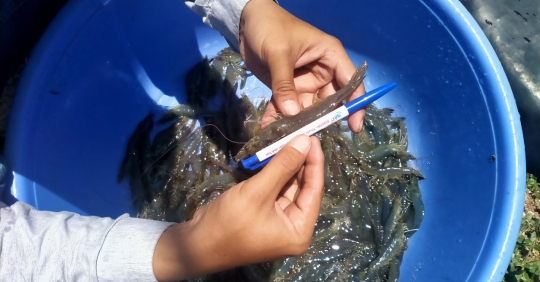
Mr. Le Minh Chinh for thorough treatment to prevent microsporidian disease (EHP) in ponds. Picture: KS.
EHP stands for (Enterocytozoon hepatopenaei) and is a dangerous disease that commonly occurs in white leg shrimp. This disease is caused by parasites that slow down shrimp growth and severely affect farmers’ economic efficiency.
EHP appeared in many countries with a developed shrimp farming industry, such as E.g.: China, Thailand, India, Malaysia, Indonesia… In Vietnam, microsporidian disease (EHP) has been present since 2015.
Mr. Le Minh Chinh, director of Aquaculture Cooperative in Ninh Phu Township, Ninh Hoa City (Khanh Hoa), said microsporidial diseases (EHP) are very rare in farmed shrimp each year. However, at the beginning of 2022, due to the complicated weather and unfavorable environment, EHP diseases appeared on a large scale and caused difficulties for the shrimp farming industry in the central region.
“A lot is happening with the capture of shrimp farmers from as far north as Binh Thuan province. Even the family’s big farms and dual-crop growing area are affected by EHP,” said Mr. Le Minh Chinh, sharing.

Ponds are soaked with lime in aquatic products in combination with caustic soda. Picture: KS.
With 35 years of experience in brackish water shrimp farming, he is also a pioneer in the successful application of Vannamei shrimp farming model through semi-biofloc technology since 2014, Mr. Chinh said, for this disease, if farmers do not thoroughly solve the original solution, it is difficult for shrimp farming to return to favorable conditions.
Since parasites are still present in ponds and equipment, farmed shrimp are definitely infected with EHP after about 1 month of stocking. And when cultured shrimp are infected with microspores (EHP), it leads to isolated deaths and it is difficult to get them below 100 shrimp/kg.
Signs of EHP disease usually appear in shrimp after 1 month of stocking with white faeces, but only a few grains swim. Shrimp tended to eat less, change color, and swim along the shore rather than lying low to the bottom like a normal shrimp pond.
Mr. Le Minh Chinh’s long experience of using EHP in an effective shrimp farm is that it is not advisable to extend the breeding period as the more you raise it, the more profitable it is. For easily infected shrimp, farmers can grow them to export size and then harvest them. However, heavily infected ponds require quick harvesting and thorough treatment of the pond before restocking.

Ninh Phu Commune Aquaculture Cooperative shrimp farming model. Picture: KS.
However, EHP disease in shrimp cannot simply be eliminated by chlorine, potassium permanganate and formol. Mr. Chinh often uses lime in seafood Ca(OH)2 in combination with caustic soda (sodium hydroxide) to raise the pH above 10. Usually, he often uses 1 m3 of water, about 3 kg of caustic soda, combined with lime water everything, everything in the crab pond, including the equipment. Also, open a siphon pit at the bottom of the pond to let caustic soda and lime seep to the bottom of the pond to solve the whole problem.
Then soak this water in caustic soda and lime for 3-4 days in the pond and at the same time water the equipment and pond banks again before this water is transferred to another pond. Note, however, that when transferring caustic soda and lime for treatment from one pond to another, the pH must also be checked to be above 10.
For the pond that transferred caustic soda and lime to another pond, Mr. Chinh reverses the pH in the pond below 5 by using HCl acid in combination with chlorine to thoroughly wash the equipment for the cultivation process, and then proceeds to the new farming.

Mr. Chinh’s family’s shrimp reached 65 shrimp/kg after 62 days. Picture: KS.
Normally, Mr. Chinh uses 0.5 liter of 32% acid with 5kg of chlorine for 1 block of water and uses it in the afternoon coolness. Note that the use of acid should be careful, farmers should wear protective gear or masks.
As for the water source for the new crop, it also needs to be treated more carefully in the tailings pond, namely earlier when the 20ppm chlorine dose was used, now it is increased to 30ppm chlorine.
Next, use about 2kg of potassium permanganate per 1000m3 of water and about 2-3 liters of hydrogen peroxide per 1000m3 of water to calm the water before pumping water into the pond. If you leave plenty of water out of organic farming, it will certainly never be raised again, nor reinfected with EHP on farmed shrimp.
Mr. Chinh’s experience of handling EHP as above has helped the family’s third agricultural harvest go smoothly, shrimp grow and develop well. After 62 days, his farmed shrimp reached the size of 65 shrimp/kg, very excited.

